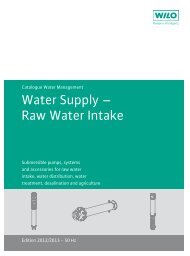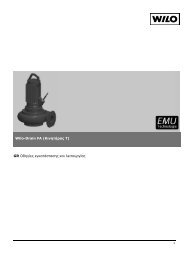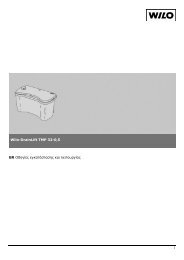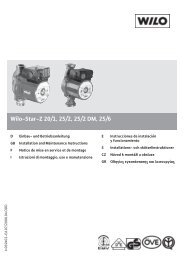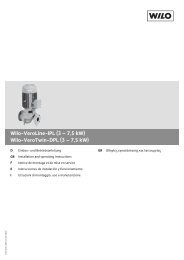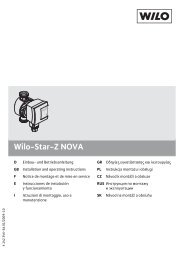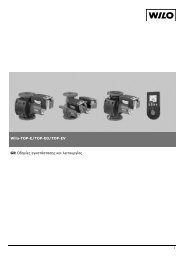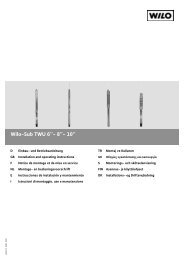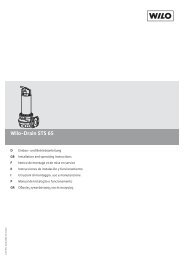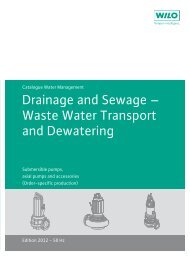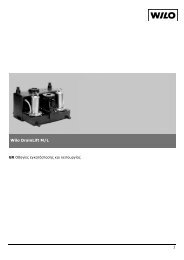'UDLQDJH DQG 6HZDJH À :DVWH :DWHU &ROOHFWLRQ; ... - WILO
'UDLQDJH DQG 6HZDJH À :DVWH :DWHU &ROOHFWLRQ; ... - WILO
'UDLQDJH DQG 6HZDJH À :DVWH :DWHU &ROOHFWLRQ; ... - WILO
You also want an ePaper? Increase the reach of your titles
YUMPU automatically turns print PDFs into web optimized ePapers that Google loves.
Planning guideBasic hydraulic principlesVibrations and resonanceWhen sewage pumps are installed and connected, various aspectsmust be observed to guarantee smooth operation. Fundamentally,every moving machine part causes vibrations.In the case of submersible motor pumps and monobloc pumps, duringrotation, free centrifugal forces are generated at the circulationfrequency. Also, the hydraulic forces acting on the pump impellerconsiderably contribute to the machine vibrations.In order to avoid malfunctions and damage, the strength of the vibrationsin the operating state may not exceed a certain threshold. Thisis achieved by statically and dynamically balancing the correspondingparts.If the pumps are subject to additional external vibrations due to unfavourableinstallation and connections, these vibrations are superimposed.These vibrations can put high levels of stress on individualcomponents.In order for the pumps to work without disturbances and to have longservice lives, they must be installed according to the generally validrules of technology.General notes• The volume flow to be handled by the pump must exceed the volumeflow of approaching sewage. Make sure that the pumps run as closeto the optimum duty point as possible to ensure durability and optimumperformance.• Consider a loss in performance with increasing pump age. The volumeflow and pressures can be negatively influenced by abrasion and corrosion.• Design the pump so that it operates as efficiently as possible.• Steep pump curves prevent clogging in the pressure pipe, since whenthere's increased backpressure, the pump also increases pressurealong its pump curve and rinses away the deposits.• When selecting accessories, take the material properties into considerationwith regard to the corrosion- and abrasion-resistance.• Compensate for peak inflows for economical and safety reasons byusing double-pump systems (pump splitting, standby pump is alwaysto be considered separately).• If the transfer point (drainage pipe) lies underneath the sump level,ventilation should be provided, since otherwise the created suctioncould empty the complete sump, incl. the pump. This would result inventilation difficulties and should therefore be checked in advance.• Observe the various operating conditions for pipes which are not permanentlyinstalled in one place. The partial and full-filling situationsshould be observed.Pipe and pump materialWhen designing, observe that the following influences could meanadditional requirements for your system:• Flow velocity of the fluid > Noises, wear• pH value of the fluid > Material damage, corrosion• Chemical constituents of the fluid > Corrosion• Atmospheric conditions, such as humidity, salt content in the air, etc.> Corrosion• Outside and fluid temperature > Fluid aggressiveness, corrosion• Dwell time of the fluid in the pipe > Odour development• Leakage currents due to using materials having different electronnegativityDue to the material changes and the resulting pressure level change,pipes for underground use should be designed as PN 10 pipes.Wilo Water Management catalogue – 50 Hz – Drainage and Sewage – Waste water collection and transport – Edition 2012/2013 – Subject to change without prior notice9




